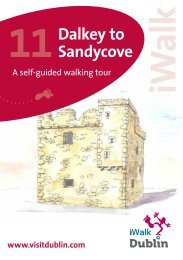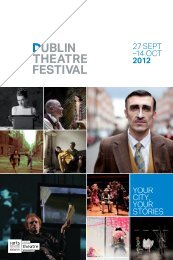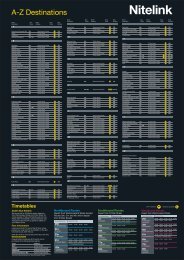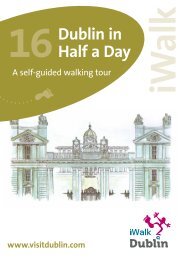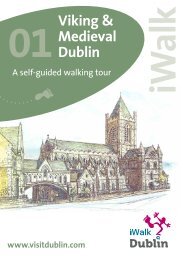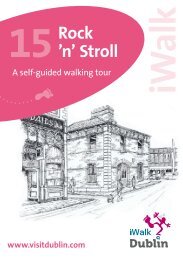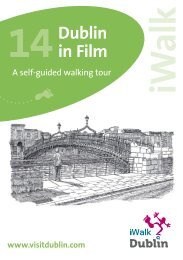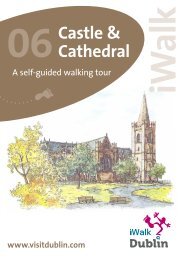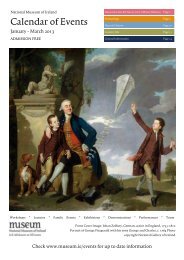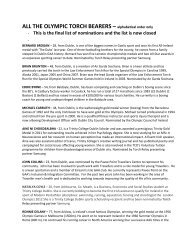iWalk 10 Howth - A self-guided walking tour - Visit Dublin
iWalk 10 Howth - A self-guided walking tour - Visit Dublin
iWalk 10 Howth - A self-guided walking tour - Visit Dublin
Create successful ePaper yourself
Turn your PDF publications into a flip-book with our unique Google optimized e-Paper software.
<strong>10</strong> <strong>Howth</strong><br />
A <strong>self</strong>-<strong>guided</strong> <strong>walking</strong> <strong>tour</strong><br />
<strong>iWalk</strong><br />
www.visitdublin.com
Welcome<br />
to <strong>Dublin</strong><br />
We hope that as you take time to walk<br />
around and explore <strong>Dublin</strong> you will discover<br />
the Irish capital is at the very heart of Irish<br />
culture and offers endless choices to our<br />
visitors. <strong>Dublin</strong>’s real appeal is her people,<br />
so don’t be afraid to stop and ask for<br />
directions along your walk – <strong>Dublin</strong>ers’<br />
hospitality and wit will captivate you!<br />
www.visitdublin.com/iwalks<br />
Sutton DART Station 4<br />
Sutton Cross 4<br />
Sutton Dinghy Club 4<br />
Entrance to Public Right of Way 5<br />
Martello Tower 5<br />
Sheilmartin Hill 6<br />
Bog of Frogs 6<br />
The Summit 7<br />
St Mary’s Abbey 7<br />
Start of the East Pier 8<br />
To the end of the East Pier 8<br />
Beside the <strong>Howth</strong> Yacht Club 8<br />
Optional Walk to the West Pier 8<br />
<strong>Howth</strong> Castle 9<br />
Route Map <strong>10</strong>
4<br />
Stop 2: Sutton Cross<br />
You will have either arrived here after <strong>walking</strong><br />
from the DART Station or you will have alighted<br />
from a bus.<br />
Stop 1: Sutton DART Station<br />
The <strong>tour</strong> commences at the DART station at Sutton or,<br />
if you have arrived by bus, from Sutton Cross (in which<br />
case move now to stop 2). When you exit the Railway<br />
Station, walk in the direction that is directly leading<br />
away from the main door of the station building. If you<br />
are unsure just ask to be directed towards Sutton Cross.<br />
Stop 3: Sutton Dinghy Club<br />
At Sutton crossroads take Greenfield Road which goes off to the<br />
south-east or left-hand side of the Marine Hotel. Your first main<br />
objective, Sheilmartin Hill, rises up straight ahead like a mini<br />
mountain range. But first, when you reach it, enjoy a pleasant<br />
coastal walk along the tidal shore. If the tide is out you can<br />
walk on the beach past stranded boats and people digging for<br />
fish bait. At the next junction keep to the coast-hugging Strand<br />
Road – rejoin the road if you have been on the beach. The road<br />
now narrows and the path disappears, but keep close to the wall<br />
facing the on-coming traffic, of which there is very little anyway.<br />
Stop at the Sutton Dinghy Club.
5<br />
Stop 4: Entrance to Public Right of Way<br />
Shortly after passing the Sutton Dinghy Club you will arrive at a group of houses<br />
with interesting architectural facades, the very apogee of Victorian coastal design.<br />
Just beyond these houses, where the road curves away from the strand and the first<br />
house on your right-hand side appears, enter a well-trodden pathway which still<br />
skirts the coastline.<br />
Stop 5: Martello Tower<br />
Commence <strong>walking</strong> along the path which, for now, moves closer to the cliff edge, so please be<br />
careful. There is a complete cliff walk which skirts the whole peninsula until arriving at <strong>Howth</strong><br />
village but you will only be <strong>walking</strong> along this first part of it. On another occasion you may<br />
like to travel the entire Cliff Walk system as a separate expedition. To the left of the rather flat<br />
terrain and in among the trees is the red-brick former manor house known as Sutton Castle.<br />
This was built in the 19th century as a home for the Jameson family who were once famous<br />
whiskey makers in <strong>Dublin</strong>. It has now been converted and added<br />
to as an apartment complex. Ahead, built on top of the sea rocks,<br />
is a round building known as a Martello tower, your next stop.
6<br />
Stop 6: Sheilmartin Hill<br />
Continue <strong>walking</strong> along what soon becomes narrower and more typical of the cliff walk. From<br />
here to the north-east corner of the peninsula, the cliffs and hidden coves provide shelter for an<br />
abundance of seabirds including herring gulls, kittiwakes, fulmars, razorbills, guillemots and the<br />
larger cormorants and kestrels. Offshore, two species of seal are fairly widespread, the common and<br />
grey seal.<br />
A large clump of rock now appears ahead, its colour giving the district its name, Red Rock. Since<br />
1996 this whole area, along with the cliff terrain from here to the Summit, a place you will be<br />
visiting later, has been protected from further development by a special government order. Take the<br />
left track around the rock formation (at the sign announcing ‘Warning No Through Path’) and head<br />
towards the distant houses. At another sign, ‘Warning Dangerous Cliffs’, turn left again which will<br />
lead you through the shrubbery and a derelict metal gateway on to Carrickbrack Road. Carefully<br />
cross this road and head left until you encounter the unobstructed view of the next hill on your<br />
right. Stop at an open part of the low wall dividing the path from the hill.<br />
Stop 7: Bog of Frogs<br />
Make your way down the path to the left which is marked by a direction<br />
sign. This time your walk is through a carpet of heather which from July to<br />
September displays a profusion of crimson-purple flowers. The object of the<br />
exercise is to get clear of the golf course as quickly as possible to avoid both<br />
being hit by stray balls and damaging the course it<strong>self</strong>. Follow the path beside<br />
the cottage, now a storage shed, which is outlined by white stones and keep<br />
<strong>walking</strong> until you reach Muck Rock Hill. Stay close to the northern edge of the<br />
Bog of Frogs, a valley peat bog. It is close to a group of four Scots pine trees and<br />
is raised slightly above the level of the surrounding ground.
Stop 8: The Summit<br />
Don’t be concerned if you get a little confused about<br />
which of the many trodden paths you should now take.<br />
Even if you take a wrong path, as long as you head in<br />
an easterly direction, you will eventually re-emerge<br />
somewhere along Windgate Road. To help you find the<br />
best route look out for some high pylons and head in<br />
their direction. Close to the pylons you will find a path<br />
that will take you between the Loughoreen Hills and<br />
Black Linn, past a quarry and out on to Windgate Road.<br />
First turn right, then left, into Windgate Rise, near the<br />
end of which is an exit covered by three bollards which<br />
will lead into Thormanby Road. A short distance ahead is<br />
the Summit Inn, a pub where, if you are in need, you may<br />
seek refreshment. Next, continue up Bailey Green Road<br />
to the viewing area where there is a stupendous prospect<br />
that encompasses the whole bay area with its varied<br />
shipping and miscellaneous lighthouses.<br />
7<br />
Stop 9: St Mary’s Abbey<br />
Just below the bungalow, you can take the upper cliff walk, which is a relatively<br />
wide and safe pathway, which swings around East Mountain and leads eventually<br />
onto Upper Cliff Road. You can, of course, walk all the way down to the Baily<br />
Lighthouse and back again, if you wish. From Upper Cliff Road, move downhill along<br />
Thormanby Road into the fishing village of <strong>Howth</strong>, a place which, until recently,<br />
modern progress had ignored. The new buildings are, by and large, in sympathetic<br />
agreement or in pleasing contrast to the old, and the village has taken on a more<br />
welcoming sophistication.<br />
Keep heading downhill, until, having<br />
passed the Baily Court Hotel, you take<br />
the left-hand uphill road at the next<br />
junction. The parochial hall on your<br />
left, built in 1814, was the original<br />
church for the Roman Catholics until<br />
the present church, which you passed<br />
a few minutes ago, was opened in<br />
1899. Straight ahead, at the next bend,<br />
is one of the most important buildings<br />
in <strong>Howth</strong>, St Mary’s Abbey with its<br />
graveyard and collegiate building.
8<br />
Stop <strong>10</strong>: Start of the East Pier<br />
Return back down to Abbey Street via the steepish stone steps to your right which is situated between a<br />
pair of buildings. The steps will lead you out beside the Abbey Tavern, one of the best-known entertainment<br />
pubs in <strong>Dublin</strong>, where Irish songs, ballads and other traditional entertainments may be enjoyed. Now<br />
continue downhill. The castellated boundary walls of the former <strong>Howth</strong> Abbey merge into some<br />
apartment and retail complexes. At the end of the road cross over and pause for a while at the<br />
entrance to the long pier straight ahead, which is known as the East Pier.<br />
Stop 11: To the end of the East Pier<br />
You will now commence to walk down the pier it<strong>self</strong> which has been a favourite<br />
promenade of <strong>Dublin</strong>ers since Victorian days. I would recommend that you walk down<br />
on the upper parapet level and return by way of the lower level. Be very careful <strong>walking</strong><br />
along the lower pier where working trawlers or other boats may be tied up. Netting,<br />
cables and other pieces of equipment may lie across the path and trip the unwary.<br />
Here and there, the surface of the East Pier can be a bit uneven and there can be gaps<br />
between the granite slabs, so mind where you place your feet. Avoid the East Pier in<br />
stormy weather or when a strong east wind is blowing, particularly on the upper level,<br />
as it can be washed with great spumes of water.<br />
So then, climb up the few steps onto the higher level and before commencing, take in<br />
the seaward view to your right towards the cove of Balscadden Bay, which is overlooked<br />
by a scattering of houses clinging to the side of the hill. Then start the walk to the end<br />
of the pier which is about 750m long. Stop at the lighthouse.<br />
Stop 12: Beside the<br />
<strong>Howth</strong> Yacht Club<br />
Now take the steps down to the lower level to return<br />
back to the village. Turn right along the harbour wall<br />
and continue until you pass the <strong>Howth</strong> Yacht Club<br />
and walk across to the water-side again before<br />
stopping to have a look at all the parked yachts.<br />
Stop 13: Optional Walk to the West Pier<br />
I would expect that most people are tired by now and all too ready to rest in a café, bar or restaurant<br />
or indeed, to take the DART back to <strong>Dublin</strong> city. But there are a couple of options if you have the<br />
endurance to take them. Walk along Harbour Road and turn into the next pier, which is called the<br />
West Pier. Meander on to the end of the pier taking in the sights. On the return you will have an<br />
opportunity to study the trawlers themselves – providing the fleet is in, of course. Climb the curving<br />
steps at the pier’s end and scan the horizon in all directions. There is an excellent view of Sutton and<br />
Claremont Strand to the west, and Portmarnock, Malahide and Donabate to the northwest.
9<br />
Stop 14: <strong>Howth</strong> Castle<br />
Return up the pier on the left-hand side, taking care not to trip over tying-up ropes, hawser lines, nets,<br />
fish boxes and all the trappings of a busy fishing port. There are about 40 vessels of all shapes and sizes<br />
in the <strong>Howth</strong> fishing fleet, although the once traditional small wooden trawler is now almost a thing of<br />
the past, and the gargantuan ocean-going trawlers-cum-processing-factories are mainly concentrated<br />
in Ireland’s south and northwest ports. The <strong>Howth</strong> fleet confines it<strong>self</strong> almost entirely to the Irish Sea,<br />
and the fish landed here are mainly cod, plaice, whiting, haddock, sole, hake, mackerel, herring and<br />
prawn. Looking down into the decks of the trawlers, you can easily see how tough and hazardous the<br />
profession is. A major rebuilding of the harbour was undertaken and finished in 1986, when additional<br />
piers and facilities were built.<br />
A short walk out of the village by way of the DART Station will bring you to the entrance of the National<br />
Transport Museum and <strong>Howth</strong> Castle. A sign on the left-hand side of the road indicates where you<br />
should turn left and enter through a gateway.<br />
The Transport Museum is literally packed with a<br />
huge range of vehicles, from a fully restored Hill<br />
of <strong>Howth</strong> Tram to a humble horse-drawn delivery<br />
vehicle. Trams, buses, fire engines, military vehicles<br />
and commercial transport make up an extremely<br />
interesting and rare collection. During the summer<br />
months the museum is open every day except<br />
Sunday between <strong>10</strong>.00 am and 5.00pm. During the<br />
rest of the year it is only open Saturdays, Sundays<br />
and bank holidays from 2.00 to 5pm.<br />
Further uphill from the museum is the venerable<br />
<strong>Howth</strong> Castle which owes its origins to the Norman<br />
knight, Sir Almeric Tristam, who wrested the<br />
peninsula from the Norsemen in 1177. Walk to<br />
the front of the castle where you can see the main<br />
residence.
GREENFIELD ROA<br />
<strong>10</strong><br />
<strong>iWalk</strong><br />
route map<br />
To the end of<br />
the East Pier<br />
Start of the East Pier<br />
West Pier<br />
Sutton DART Station<br />
Sutton Cross<br />
01<br />
STATION ROAD<br />
SUTTON<br />
02<br />
HOWTH R<br />
CHURCH ROAD<br />
<strong>Howth</strong> Castle<br />
Beside the<br />
<strong>Howth</strong> Yacht Club<br />
St Mary’s Abbey<br />
The Summit<br />
Bog of Frogs<br />
Sheilmartin Hill<br />
Sutton Dinghy Club<br />
Entrance to<br />
Public Right of Way<br />
Martello Tower
11<br />
11<br />
13<br />
HOWTH ROAD<br />
OAD<br />
12<br />
<strong>10</strong><br />
OFFINGTON PARK<br />
OFFINGTON DRIVE<br />
14<br />
HARBOUR ROAD<br />
CHURCH STREET<br />
09<br />
ST. LAWRENCE ROAD<br />
BALSCADDEN ROAD<br />
D<br />
DEER PARK GOLF COURSE<br />
GRACE O’MALLEY DRIVE<br />
MAIN STREET<br />
ST MARYS ROAD<br />
HOWTH<br />
NASHVILLE ROAD<br />
NASHVILLE PARK<br />
CARRICKBRACK HILL<br />
BALKILL PARK<br />
BALKILL ROAD<br />
DUNGRIFFEN ROAD<br />
CARRICKBRACK ROAD<br />
THORMANBY ROAD<br />
03<br />
CARRICKBRACK LAWN<br />
STRAND ROAD<br />
ST FINTANS PARK<br />
ST FINTANS CRESCENT<br />
07<br />
WINDGATE ROAD<br />
FINTANS ROAD<br />
KITESTOWN ROAD<br />
CARRICKBRACK ROAD<br />
HOWTH GOLF COURSE<br />
06<br />
04<br />
SHIELMARTIN ROAD<br />
SUTTON<br />
HOUSE<br />
THORMANBY ROAD<br />
08<br />
05<br />
WINDGATE ROAD<br />
CARRICKBRACK<br />
ROAD<br />
CARRICKBRACK ROAD
We hope that you enjoyed this walk<br />
which was narrated by its author,<br />
Pat Liddy, who may be visited on his<br />
website www.<strong>walking</strong><strong>tour</strong>s.ie and<br />
brought to you by Fáilte Ireland on<br />
www.visitdublin.com<br />
For the latest updates on <strong>walking</strong><br />
<strong>tour</strong>s of <strong>Dublin</strong>, check out our website:<br />
www.visitdublin.com/iwalks<br />
Our offices are located at:<br />
Suffolk Street, <strong>Dublin</strong> 2<br />
14 Upper O’Connell Street, <strong>Dublin</strong> 1<br />
Terminal 1 Arrivals Hall, <strong>Dublin</strong> Airport, County <strong>Dublin</strong><br />
Terminal 2 Arrivals Hall, <strong>Dublin</strong> Airport, County <strong>Dublin</strong><br />
Thank you for visiting our city<br />
© The copyright for this text is owned by Pat Liddy and such copyright has been asserted<br />
by him. He has made this text available to be exclusively used by Fáilte Ireland.<br />
FI-22496-13



